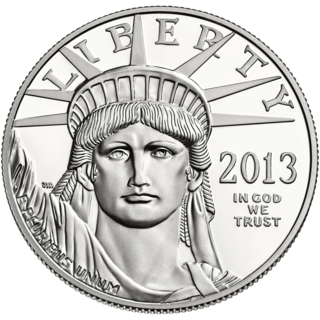
The quarter, short for quarter dollar, is a United States coin worth 25 cents, one-quarter of a dollar. It has a diameter of .955 inch (24.26 mm) and a thickness of .069 inch (1.75 mm). The coin sports the profile of George Washington on its obverse, and its reverse design has changed frequently. It has been produced on and off since 1796 and consistently since 1831.
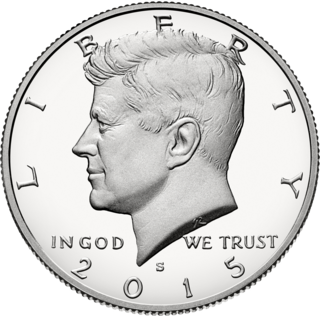
The half dollar, sometimes referred to as the half for short or 50-cent piece, is a United States coin worth 50 cents, or one half of a dollar. It is the largest United States circulating coin currently produced in both size and weight, being 1.205 inches (30.61 mm) in diameter and .085 inches (2.15 mm) in thickness, and is twice the weight of the quarter. The coin's design has undergone a number of changes throughout its history. Since 1964, the half dollar depicts the profile of President John F. Kennedy on the obverse and the Seal of the President of the United States on the reverse.

The United States Mint has minted numerous commemorative coins to commemorate persons, places, events, and institutions since 1848. Many of these coins are not intended for general circulation, but are still legal tender. The mint also produces commemorative medals, which are similar to coins but do not have a face value, and therefore are not legal tender.
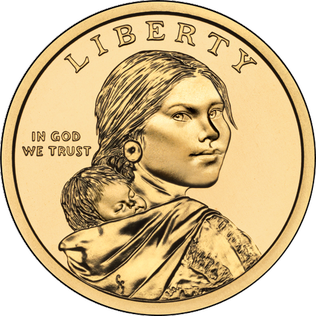
The dollar coin is a United States coin with a face value of one United States dollar. It is the second largest U.S. coin currently minted for circulation in terms of physical size, with a diameter of 1.043 inches (26.5 mm) and a thickness of .079 inches (2 mm), coming second to the half dollar. Dollar coins have been minted in the United States in gold, silver, and base metal versions. Dollar coins were first minted in the United States in 1794. The term silver dollar is often used for any large white metal coin issued by the United States with a face value of one dollar, whether or not it contains some of that metal. While true gold dollars are no longer minted, the Sacagawea, Presidential, and American Innovation dollars are sometimes referred to as golden dollars due to their color.

The 50 State quarters was a series circulating commemorative quarters released by the United States Mint. Minted from 1999 through 2008, they featured unique designs for each of the 50 US states on the reverse.
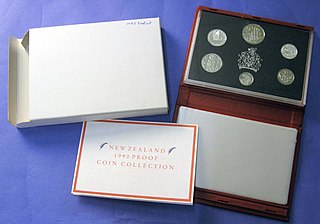
Proof coinage refers to special early samples of a coin issue, historically made for checking the dies and for archival purposes, but nowadays often struck in greater numbers specially for coin collectors (numismatists). Nearly all countries have issued proof coinage.

Presidential dollar coins are a series of United States dollar coins with engravings of relief portraits of U.S. presidents on the obverse and the Statue of Liberty on the reverse.

The Sacagawea dollar is a United States dollar coin first minted in 2000, although not released for general circulation from 2002 to 2008 and again from 2012 onward due to its general unpopularity with the public and low business demand for the coin. These coins have a copper core clad by manganese brass, giving them a distinctive golden color. The coin features an obverse by Glenna Goodacre. From 2000 to 2008, the reverse featured an eagle design by Thomas D. Rogers. Since 2009, the reverse of the Sacagawea dollar has been changed yearly, with each design in the series depicting a different aspect of Native American cultures.

The West Point Mint Facility is a U.S. Mint production and depository facility erected in 1937 near the U.S. Military Academy in West Point, New York, United States. Originally it was called the West Point Bullion Depository. At one point it had the highest concentration of silver of any U.S. mint facility, and for 12 years produced circulating pennies. It has since minted mostly commemorative coins and stored gold.

The Barber coinage consists of a dime, quarter, and half dollar designed by United States Bureau of the Mint Chief Engraver Charles E. Barber. They were minted between 1892 and 1916, though no half dollars were struck in the final year of the series.

The Washington quarter is the present quarter dollar or 25-cent piece issued by the United States Mint. The coin was first struck in 1932; the original version was designed by sculptor John Flanagan.
Donald Nelson Everhart II is an American coin and medal engraver-medalist, and sculptor who has worked for the private Franklin Mint, as a freelance designer, and since 2004 has worked for the United States Mint in Philadelphia. With over 1,000 models for coins and medals attributed to him as of 2008, he is still at the prime of his career creating the bas-relief models for these and similar sculptural objects. His coin designs are in the pockets of American citizens, and despite his late arrival to the series of the popular U.S. Statehood Quarters, he has designed and modeled three State's unique reverse designs, modeled three others, and six U.S. commemorative coins. His portrait of President William Clinton was chosen for Clinton's second term Inaugural Medal. Among his other medal creations are six Congressional Gold Medals for the U.S. Mint, seven Society of Medalists issues, twelve calendar medals, and other models for private medal makers, as well as cast art medals.

The District of Columbia and United States Territories quarters were a series of quarters minted for one-year by the United States Mint in 2009 to honor the District of Columbia and the unincorporated United States insular areas of Puerto Rico, Guam, the United States Virgin Islands, American Samoa, and the Northern Mariana Islands. The islands commonly grouped together as the United States Minor Outlying Islands were not featured, as the law defined the word "territory" as being limited to the areas mentioned above. They followed the completion of the 50 State Quarters Program. The coins used the same George Washington obverse as with the quarters of the previous 10 years. The reverse of the quarters featured a design selected by the Mint depicting the federal district and each territory. Unlike on the 50 State quarters, the motto "E Pluribus Unum" preceded and was the same size as the mint date on the reverse.

The America the Beautiful quarters are a series of 25-cent pieces (quarters) issued by the United States Mint starting in 2010 and scheduled to continue until at least 2021. The series may be extended at the option of the Secretary of the Treasury, potentially to 2032. The obverse (front) of all the coins depicts George Washington in a modified version of the portrait used for the original 1932 Washington quarter. There will be five new reverse (back) designs each year, each commemorating a national park or national site – one from each state, the federal district, and each territory. The program is authorized by the America’s Beautiful National Parks Quarter Dollar Coin Act of 2008.
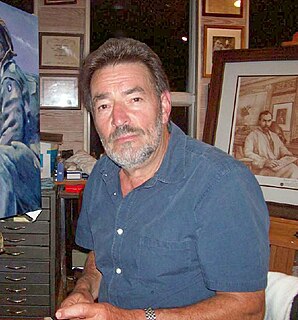
Joel Iskowitz is an American designer, book illustrator, print artist and stamp, coin and medal designer. From an initial interest in medical illustration, this graphic artist has branched to other fields. He specializes in highly realistic art resulting from extensive research to make his designs as accurate as possible. His philatelic (stamp) designs, he once said, "must be super accurate and well documented, for if you get so much as an animal's tuft of fur out of place on a philatelic design you will hear from someone critical of your design." Among his coin designs are the reverse of the 2009 Lincoln Bicentennial penny, 2008 Arizona State Quarter, 2009 District of Columbia Quarter, and the upcoming 2016 Nancy Reagan First Spouse Gold Coin. In 2011 he was inducted into the Hunter College Hall of Fame. A major address on his career as a designer of commemorative coins and medals, at the Museum of American Finance in October 2015, was aired on C-SPAN.
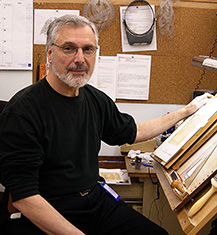
John M. Mercanti is an American sculptor and engraver. He was the twelfth Chief Engraver of the United States Mint until his retirement in late 2010.
The United States Mint has released annual collections of coins most years since 1936.
Thomas S. Cleveland is an American designer, illustrator and fine artist. He served in the United States Mint's Artistic Infusion Program from 2004 until 2014.

American Innovation dollars are dollar coins of a series minted by the United States Mint beginning in 2018 and scheduled to run through 2032. It is planned for each member of the series to showcase an innovation, innovator or group of innovators from a particular State or territory.
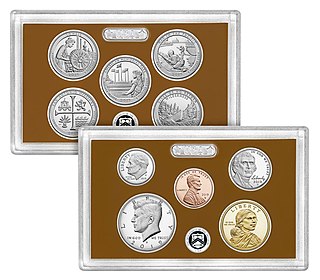
The United States Mint Proof Set, commonly known as the Proof Set in the United States, is a set of proof coins sold by the United States Mint. The proof set is popular with coin collectors as it is an affordable way to collect examples of United States coinage in proof condition.

